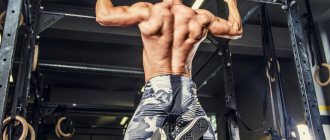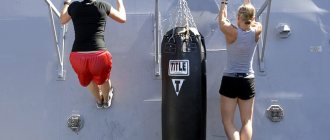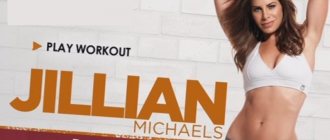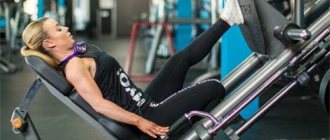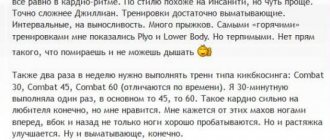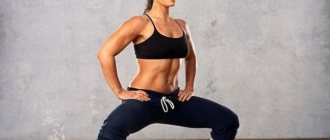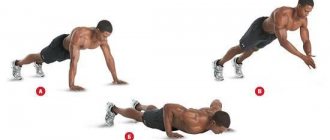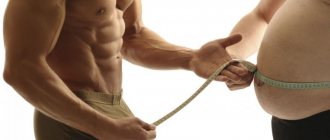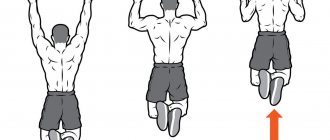Lower body exercises. Lower body exercises!
As you know, the female body is designed so that excess fat accumulates in the lower part of the body, while the upper part can sometimes be quite miniature.
These exercises are aimed at working the lower body, legs, hips and abdomen. Perform these exercises every other day to give the body time to recover, and we also do not forget about proper nutrition, since nutrition is the basis of the entire weight loss process! 1. legs.
Cross lunge, gluteal muscles. Stand straight, feet together, back straight, hands on your waist. Then smoothly move your right leg diagonally back and squat down so that your knees are bent at a right angle, but your back leg does not touch the floor. Return to the starting position and repeat the exercise on the other leg.
2. calf muscles. Stand straight, facing the chair, place your right foot on the seat closer to the center. Rise up onto a chair, shifting your body weight to your right leg. Lower your left leg down to the floor diagonally until it is in front of the right leg of the chair. Repeat on the other leg.
3. Bend over with dumbbells, back of the thigh. Take dumbbells and place your feet shoulder-width apart. Slowly, looking straight ahead, without arching at the waist or bending your knees, lower your arms down, as if rolling dumbbells along your legs. Then repeat this movement in the opposite direction.
4. press. “Bicycle”, internal oblique muscles of the abdomen. Lie down on the floor. Clasp your hands behind your head, raise your legs. At the same time, bend your left knee and, slightly turning your body, reach towards it with your right elbow. Repeat on the other leg.
5. lateral bending, external oblique abdominal muscles. Take a dumbbell in your right hand, touch your temple with the fingers of your left hand, as if you are saluting. Slowly bend to the right behind the dumbbell. Then, without straining your neck, straighten up. Repeat for the other hand.
6. lower twist, rectus abdominis muscle. Lying on the floor, bend your legs and lift them so that your shins are parallel to the floor. Spread your arms to the sides; Without changing the position of your arms and shoulders, move your knees now to the right, now to the left, almost touching the floor.
In Dahl's dictionary
m. opposite sex top, height: the part or end of an object facing the ground, foot, base, bottom, end, edge. The bottom of the house is stone and the top is wooden. Forge a stone bottom, base, masonry, foundation for houses. Under our huts, all the lower parts are made of stone. The bottom of the mountain is forested, the top is bare. *Better at the bottom than up the mountain, more modest. | Underside, sole, bottom; the side or side of an object on which it stands lies. The bottom of the candlestick is made of cloth. Place the bale on the bottom, don’t turn it over. | Low place, low places, low places. I walked downhill, he on horseback or uphill. Don't build on the bottom, the water will understand. We have mowing along the bottom. I distributed everything from here downwards (downwards) and went all the way to the lake. There is fog in the lower areas, they don’t allow you to mow until the sun shines. | A place that lies further, downstream of a river, lower reaches, lower reaches, lower reaches, area, further from the top and closer to the mouth. Bottom of the river, we have b. h. they mean the south (and in Siberia the north), referring this word to the Volga, which is why all the cities below Simbirsk are called grassroots; and the downwind wind is southeast. Nizova weather or Nizovok m. Sib. wind from the mouth of the river. Low m. pl. Moscow the lower, sometimes even lower, connection of rooms under the inn, a kind of black tavern and tavern. | Bottom, sib. European part of Rus'. Was. Yes, it floated to the bottom. The uninvited guests, the lower ones, broke down the new canopy. The water will carry you down, and bondage (bondage) will take you up, about barge haulers. Go to the bottom, there is wheat, to the barge haulers. So-and-so went to the bottom, swam to the lower reaches of the Volga. Our people from below have not yet returned from the Putin. | Did he go down, did he go down, they ask the patient if he had a bowel movement? Having understood this question, as it is understood on the Volga, the peasant answered the doctor: “No, I haven’t been further than Simbirsk: but my brother, he went all the way to Astrakhan.” The swallowed coin came out at the bottom. | The lower notes or sounds in music are thick, bassy. Take it from below, and I'll take it from above. | Connecting with other words, the bottom turns into a preposition, dropping ъ and sometimes replacing it, esp. before th, the letter o; before p, x, c, h,. w, w, final z changes in s. Bottom always means a movement from above, a fall, a direction towards the bottom, down, and the words of this formation are self-explanatory, for example... Throw stones from a mountain. To bring down someone from the heights of greatness. He fell into the abyss. The waterfall is falling. Overthrow cf. duration the overthrow will be completed. one-time overthrow. valid according to verb. He overthrew the remains, scraps, sediment, dirt from the wax when he stacked it. A mountain stream brings down stumps and stones. The hailstone is driven down by the burden. To bring down, to bring down someone from the ladder, from the world of dreams into the material world. To bring down, to bring down, to press from above, to press. Pressure of water to the bottom of the vessel. To overthrow, to overthrow the arrogant enemy. Nizkovoditsa low water avg. low, low water. Low-dollar m.-lie avg. lowland. The water cannon falls and breaks apart as it falls. To the one who asks, the Lord sends down or will send down his blessing. The sending lasts. the sending will end. valid according to verb. The eagle descends, descends, plunges from the cliff. Descend from the mountains. Descend to the needs of your neighbor. The sun is going down towards sunset. Descent cf. duration the descent will end. valid according to verb.
Lower body exercises for girls. How to choose a training program for a girl
- More repetitions. The standard number of repetitions for weight gain for men is 6 – 10. However, women have significantly more type I muscle fibers, so it is recommended to do from 8 to 15 repetitions for muscle growth.
- In women, the lower body grows better. That is, the buttocks and thighs are much more amenable to mass training than the upper body. In addition, a girl with a more developed bottom than top looks much more beautiful than the other way around. Conclusion: 40% - 50% of exercises should be on the legs and buttocks. Approximately 20% on the back. And 10% each on the chest, arms and shoulders. For example, you train 3 times a week and do 24 exercises in 3 workouts. That means 10 exercises for the legs and buttocks. 5 On your back. And 3 exercises for the chest, shoulders and arms.
- Don't forget that the chest and back muscles need the same target load as the buttocks, biceps or abs. Therefore, choose exercises for the upper body too.
- It is advisable that the training duration for girls should not be less than 1 hour, because only this will give the desired effect of burning fat.
- At the initial stages of training, girls should train for the whole body and only with experience switch to split programs.
In the dictionary D.N. Ushakova
BOTTOM, bottom, plural. bottoms, male 1. units only The part of an object closest to the base, to the ground. The bottom of the house is stone. From bottom to top. | Side, edge on which an object rests, which touches the surface when standing (special). The bottom of porcelain products is not glazed. | Bottom floor of the house (colloquial). The upstairs has nice rooms and the downstairs is occupied by a shop. 2. Lower reaches of the river (obsolete). Go to the bottom. 3. only plural Unprivileged, exploited classes of society (pre-rev.). The famine caused unrest among the lower classes. Old *****
https://youtu.be/RWKpRykhTxk
Lower body exercises for women in the gym. Principles of women's training
- Training in the range of 4-6 repetitions to increase strength, and 7-12 to increase volume (muscle hypertrophy). Anything over 12 is already training for cardiovascular endurance.
- But there is one “but”. The female body contains many type 1 muscle fibers (small fibers that are difficult to grow and respond only to high repetition, aerobic endurance exercise). Such fibers have low fatigue, which may be why women are more resilient. Given this fact, women should still aim for 8-15 repetitions per set. But, this does not mean that 4-6 repetitions cannot be used. A woman also has fast muscle fibers, which contract quickly, have great strength, but get tired quickly. Conclusion: we focus on slow fibers (8-15 repetitions), but do not forget about fast fibers (4-6 repetitions).
- You need to lift relatively heavy weights.
- As I said above, training “to failure” is not for girls. However, many cool bodybuilders of the past doubted its necessity for men. And today the debate about its necessity does not subside. For example, scientist Mikel Izquierdo discovered that after refusal training, the secretion of cortisol sharply increases and the analobic growth factors IGF-1 decrease. It was also noticed that cells experience such an acute lack of energy that protein synthesis in them is disrupted, which means growth slows down. In other words, we simply exhaust our body and in the long term, by abusing “refusal” we can slow down our progress.
- Work in basic exercises (or similar ones). For example, if you can't squat, do leg presses. There was no straightening of the legs even close in this case.
- Do not stay in the hall for more than 1 hour, maximum 1.15.
- Work your whole body. Your desire to pump things up a little here and a little here is quite understandable. But you need to understand that the whole body needs to be worked on. Over time, you can focus on any part of the body, but do not pump it exclusively. And remember that working your entire body in compound exercises is much more effective at burning calories and regulating weight than focusing on just one part of the body.
- Focus on your lower body. Women's training should consist of 50% leg exercises. 20% can be allocated to working the back, 10% - arms, 10% - shoulders, 10% - chest.
- For a beginner girl, it is necessary to work out the whole body in one workout. Only after a while can you switch to split programs (train different muscle groups separately, or the upper body separately, the lower body separately).
Exercises for the lower body at home. Exercises to work on problem areas
- Lie down on the hyperextension machine so that your pelvic bones rest against the main pillow. Cross your arms behind your head, fix your heels under the lower leg cushion. In this position, the whole body should be stretched diagonally into a string. Lower your upper body down (an angle of slightly less than 90 degrees should form). Arch your back slightly and lift your body to the starting position.
- Lie on your stomach on a leg machine bench. Press your heels into the bottom pad. Bend your knees so that the ball of your feet touches your pelvis.
- Perform the previous exercise using only one leg. First the right, then the left. The number of repetitions for both legs is the same.
- Repeat 1 exercise.
- Lie on an inclined bench with your head up. Place your hands on the back of your head. Bend to the right side. At the lowest point, move to the left side and straighten through it. Do the required number of repetitions in this direction, and then do the same, bending to the left side and returning through the right.
- Lie on your back in a leg press machine. Place your feet on the platform closer to its top edge. Place your feet at a short distance from each other. Press down on the platform, straightening your legs, and bend them at the knees again. The main load should fall on the heels, but the feet should fit tightly to the platform. The legs are parallel to each other throughout the entire exercise. It is prohibited to connect or separate them; this will reduce the effectiveness of the element and increase the risk of injury.
- Stand up straight, pick up a barbell or dumbbells and lower them in front of you. Keep your back straight, do not bend or round throughout the entire exercise. The head must also be kept motionless and the gaze straight ahead. From this position, tilt your upper body forward, moving your hands with the apparatus along the front surface of your legs. Then return to the starting position. You cannot lift your feet off the floor; they must be well fixed. Try not to transfer the main load to the lumbar region.
- Lie with your back on the floor and place your feet on a low bench or step of a wall bars. Stretch your arms at your sides, bend your legs at the knees. From this position, lift your buttocks off the floor, placing your feet on the bench. At the top point, fix the pose for a while. A burning sensation should be felt in the gluteal muscles and thighs. Perform the maximum number of repetitions. When the exercise seems simple, you can put a weight on your stomach (for example, a barbell plate). This will ensure slimming of the buttocks and help cope with the manifestations of cellulite.
Split example
And so, below I will give you an example of the best option, in my opinion, for a Top-Bottom split:
Upper Body: Workout A
- Bench press 3x5-7
- Bent-over barbell row 3x6-8
- Close grip barbell press 2x8-10
- Close-grip lat pull-down 2x8-10
- Seated dumbbell overhead press 3x8-10
Lower Body: Workout A
- Squats 3x6-8
- Hyperextensions 2x10-12
- Split squat (back leg on support higher) 2x10-12
- Games standing 4x8-10
- Barbell curl for biceps 3x8-10
Upper Body: Workout B
- Bench press or military press 3x5-7
- Wide grip pull-ups 3x6-8
- Dumbbell bench press head up, incline 30 degrees 3x8-10
- Lower block pull to the belt 2x8-10
- Dips (triceps focus) 2x10-12
Lower Body: Workout B
- Deadlift 2x8
- Leg press 3x8-10
- Leg bending lying or sitting 3x8-10
- Sitting calves 4x10-12
- Hammers for biceps 3x8-10
Only working approaches are written here, do a couple of warm-up approaches to warm up your muscles.
As you can see, I placed the biceps workout on the bottom day, this was done so that there was the same amount of exercise every day, and I also want to tell you that the biceps is one of the muscles that can use extra load for good growth.
You can also add work on the abdominal muscles on the bottom day, it won’t be superfluous.
As you can see, I divided the upper training into light and heavy exercises on different days, and also added multi-joint triceps exercises that also involve the rest of the upper body muscles.
A set of exercises for the lower body. Single leg press
4 sets of 15 reps for each leg, rest 30 seconds between sets
Before I begin the exercise, I place both feet on the top of the machine platform (quite close to each other), then lower one and immediately begin the press. You don't have to lift heavy weights at all. Due to the large number of repetitions (a total of 60 for each leg), the muscles receive a significant load.
Instead of trying to increase working weight, it is better to focus on correct movements, because technique is the key to effectiveness and the absence of injuries. Bring your knees close to your chest to achieve the proper stretch, and then exhale and push the platform, generating force through your heels.
The most effective exercises for the lower body.
Bridge
Lie on your back, bend one leg at the knee, lift the other straight. The knees are closed. Tighten your abdominal muscles and lift your pelvis as high as possible, leaning on your bent leg. Try to keep your knees, hips and shoulders in a straight line. The main load will be on the back of the thighs and gluteal muscles. Repeat 15 times on each leg. Deadlift: Stand in the middle of the expander with your feet shoulder-width apart. Grasp the ends of the elastic band with your hands. With your knees slightly bent, lean forward so that the angle between your straight back and your hips is 90°. Try not to bend your elbows or slouch—imagine holding a pencil between your shoulder blades. Slowly return to the starting position. Repeat the exercise 15 times. To complicate the task, the ends of the expander can be crossed. Steps up Stand facing a step or step 20 cm high. Take a step up, then down with the same foot. After ten steps, change legs. Continue walking for 3-5 minutes. Lunges Feet hip-width apart, stomach tucked in. Step forward one meter. Squat down so that the knees of both legs are bent at right angles. Stand up straight. Repeat 15 times on each leg. Twisting While lying down (arms behind your head), raise your knees bent. Lifting only your chest from the floor, try to reach your chest to your knees, as if twisting. It is important that your legs do not drop, your neck remains straight, and your lower back is pressed firmly to the floor. Repeat 25 times.
Using the adverb "down"
If the word “below” is used in a sentence as an adverb, then it is written only together. The following rule should be taken as a basis: an adverb is written together if it is formed from a noun that has a spatial or temporal meaning.
If we consider the noun from which the adverb “below” is formed, then it will be the following - “bottom”. It has a spatial meaning and is not specified.
An additional way to check the correctness of the continuous spelling is by inserting some other word after the consonant letter “v”. If the meaning changes or is lost, it means that the word in question is written together.
Example sentences
Let's consolidate the rule we've learned using example sentences:
- Somewhere down there, a stream was rustling. That's why we were in such a hurry to go down the mountain.
- There are headers and footers at the bottom. With their help it is easy to add pages and necessary links.
- Under the mountain, below, lies a pine forest. As a child, we loved to go there and collect pine cones.
- As soon as he felt some kind of lump below, he immediately made an appointment with a doctor.
The adverb “down” is used in the sentences. It is written smoothly.
Upper body exercises for men. Useful tips
To avoid injury in the gym, a man should adhere to the following recommendations:
- It is good to warm up your muscles and ligaments before starting each training session.
- Strictly follow the technique of performing each exercise.
Don’t forget about a balanced diet; without it, unfortunately, you won’t be able to achieve the desired weight gain and definition.
- Meals 5-6 times a day, breaks between meals are 3-4 hours.
- The diet should be rich in proteins, complex carbohydrates, and healthy fats.
- In addition to animal proteins, we must not forget about plant proteins. They contain a large amount of vitamins and microelements. Animal proteins are consumed before lunch, plant proteins - in the afternoon.
- Dinner should not be overloaded. It is better if it is represented by dairy products. For example, an hour before bedtime, you can drink a glass of kefir or homemade yogurt.
- Drinking regime is required. The opinion of many experts is 8 glasses a day. If you want to clearly calculate your daily intake, use the calculation calculator.
Lower body workout in the gym. How to train properly in the gym
The time spent on exercise machines complements and reinforces the basic exercises, but does not replace them in any way (if there are no health restrictions).
The exercise program in the gym for girls varies depending on the goals (cutting, gaining weight, etc.)
Any experienced gym trainer will tell you that the exercise program for girls is no different from the program for men. To achieve tangible results, girls should train equally with men. This does not mean that women should lift the same weight as men and completely copy the “male style” of training. However, there are general principles for both “women’s” and “men’s” training programs.
Basic rules for training in the gym (regardless of gender):
- working with heavy weights;
- the number of repetitions should depend on the goal (1-5 repetitions – muscle development, 6-12 – increasing muscle mass, more than 12 – developing endurance);
- training, including strength exercises, lasts 60 minutes (no more);
- any program covers basic (set of muscles) and conditionally basic (specific muscle group) exercises.
It is important to know! The desired forms are achieved not by the intensity of training, but by “correct”, systematic exercises. Frequent, long and chaotic training will do more harm than good.
Derivative preposition "below"
Sometimes the word “below” in its combined form is also used as a derivative preposition. This is possible when it has a dependent noun, which is used in the genitive case.
Example sentences
Let's look at examples of sentences in which the word “below” is used as a preposition:
- I request that you immediately sign the bottom of this contract. I'm in a hurry to get to a meeting!
- A nagging pain appeared in the lower abdomen that did not allow my baby to fall asleep.
- At the bottom of the list of necessary things to do, be sure to put the date of compilation.
- There is simply no free space at the bottom of this notepad page. You've already covered everything.
In each example, you can move from the preposition “down” to the noun that follows it. This confirms that the word is used as a derivative preposition and not an adverb.
Lower body workout for girls at home. Features of the female body
What is a woman's main goal in life? I think it's extremely simple. Give birth to healthy offspring and continue your family line. Therefore, the female body is “sharpened” precisely for this.
The female body tends to accumulate nutrients for the future (in reserve). This ensures better survival for the child. After all, our ancestors had big problems with food.
Women have much less anabolic hormones (testosterone) and fear hormones (adrenaline), so they are virtually unable to reach true muscle failure on a set (when the muscles are no longer able to contract properly to perform another repetition).
A man, through pain and a grimaced face, can force himself to do a couple more repetitions, and a woman (if she doesn’t foolishly use steroids), although she will be physically able to do a few more repetitions, will be forced by her brain to stop.
This is one of the ways the female body saves energy (what if the girl doesn’t have enough energy for the child on a hungry day).
Women have much less myofibrils (muscle fibers). Therefore, failure training for 6-10 repetitions, which works so effectively on men, is not suitable for them.
Women have much less muscle in their upper body than in their lower body. This is also very logical. After all, in this way a woman better protects her child (strong muscles of the legs, buttocks).
And since muscles are a very voracious thing in terms of energy, nature has endowed a woman with a smaller volume of muscle tissue in “less important” areas of the body (arms, shoulders, back, chest, neck). Therefore, women’s lower body responds very well to training.
Separately, I’ll say about girls’ abs. Because girls experience severe menstrual pain, nature has taken care of reducing the neuromuscular connection in this area so that women do not go crazy. Therefore, it is much more difficult for girls to pump up their lower abs than for men. I have a very cool article about how to quickly pump up your abs at home.
Metabolism is much slower than that of men. Energy consumption in a calm state is much less. This is necessary to ensure better survival of the child. For the same reason, women have much less muscle compared to men, because... muscles spend a large amount of energy, and this is not beneficial for bearing a fetus.
Women's muscles store glycogen better. Glycogen, let me remind you for those who have forgotten, is the fuel (energy) in our muscles, which the body devastates most quickly during physical activity.
Therefore, carbohydrates are deposited into fat much faster in girls, but at the same time, the female body converts fat into energy much more easily than the male body. The more muscle there is, the more glycogen will be stored (increasing fuel tanks).
We must remember that the required amount of carbohydrates will be easier to store in the muscles and this is good, because. gives additional volume and fullness to the muscles, but an excess amount of carbohydrates will very quickly be stored as fat deposits, and this is already bad, because Hardly anyone likes extra fat.
I know that girls really like to experiment with food (although I don’t encourage this on a diet), but I have an interesting article about protein shakes at home for a set. In the same article I talk about protein shakes for weight loss. I'm sure you'll like it!
A very important point is the menstrual cycle! It imposes certain restrictions on women's training. Now I will explain why.
In the first two weeks after menstruation, a woman feels a strong influx of strength and energy, so at this moment you can give a heavier load (strength load). After the egg has matured, ovulation occurs (approximately on days 12-16 of the cycle) and regardless of whether the egg was fertilized or not, the female body goes into an “energy-saving mode” for an average of two weeks (until the next period).
Therefore, it is very important to use MICROPERIODIZATION of loads. Those. after ovulation, do not train the lower body (legs and abs), and also switch to a lighter (lighter) load.
Aerobic exercise (fast walking, running, cycling, etc.) is best for burning fat. There is no particular difference here from men. Fat burning occurs best from brisk walking (35-50 minutes), with a heart rate of 110-130 beats per minute.
But the term “fat burning” is not entirely correct. FAT DOES NOT BURN FROM TEMPERATURE, IT OXIDATES UNDER THE INFLUENCE OF LARGE AMOUNT OF OXYGEN!
Lesson plan for the week
This split is designed as a 4-day split, so ideally you should train on the following schedule: Tuesday – Upper Body Workout #1 Wednesday – Rest Day Thursday – Lower Body Workout #2
However, if circumstances do not allow you to train 4 times a week or if you don’t have time to recover while doing this schedule, then the 3-day version of this split is suitable for you:
The triceps strengthener is a pushup in that it targets all the major muscle groups in the upper body, such as the arms, chest, shoulders, and core. However, what sets the triceps apart from a regular push-up is that by bringing your hands closer together, you place more emphasis on the triceps. This is a great exercise for those of you who are looking for a quick and effective way to tone your upper organs, especially the area at the back of the shoulder, which is at the top of most women's lists of problem areas.
The dumbbell shoulder press is a compound exercise designed to target all of the shoulder muscles, as well as the triceps and trapezius, a large muscle located on the side and back of the neck that extends as far as under the shoulder blade. The trapezius muscle is one of the largest muscles found in the human body. Those of you who spend a lot of time sitting at a desk may experience tension and muscle spasms in the back of the neck, which often affects the arms and midsection, making everyday tasks such as bending, standing, sitting or climbing stairs painful, strengthening shoulder muscles, primarily your deltoids, but also your trapezius, this exercise will help relieve many of these aches and pains, as well as improve your overall balance and posture.
Week 1
Monday - workout #1 for the lower body Tuesday - rest day Wednesday - workout #1 for the upper body Thursday - rest day Friday - workout #2 for the lower body Saturday and Sunday - rest days
Week 2
Monday – Upper Body Workout #1 Tuesday – Rest Day Wednesday – Lower Body Workout #1 Thursday – Rest Day Friday – Upper Body Workout #2 Saturday and Sunday – Rest Days
Dumbbell Lateral Raise
The side raise is a secondary movement exercise designed to work the shoulder muscles.
Strong deltoids are critical for good balance and posture. These muscles also play an important role in helping to increase the range of motion of our arms. This is because our deltoids, located at the front and back of our shoulders, are primarily responsible for helping hold our shoulders high and pulled back. This in turn prevents shoulder sagging as we age and helps our shoulders maintain an optimal range of motion. Working weights in exercises
The rep ranges prescribed above should correspond to a specific amount of weight: 6 reps – approximately 85% of one-rep max 8 reps – approximately 80% of 1RM 10 reps – approximately 75% of 1RM 12 reps – approximately 70% of 1RM
Progression of working scales
The first 2 weeks of training under this program are “test”: during this period you must determine your working weights. From week 3 you begin to train with full dedication.
As a woman, you may be concerned about excess fat on your upper body, especially on your chest, back, arms, or stomach. Too much fat in these areas can cause your clothes to perform poorly, cause body flare, or make you look self-conscious in general. Belly fat can predispose you to heart disease and metabolic disorders. However, with the right exercise regimen, you can lose weight on your upper body and the rest of your frame will be healthier and look great.
Cardiovascular exercise is essential if you want to lose weight on any part of your body, regardless of your gender or your specific problem areas. Cardio burns calories and you must create a calorie deficit to lose weight and fat. While you can't train your upper body for fat loss, you can do exercises that raise your heart rate and use large muscle groups to burn fat from the entire frame. Popular choices include jogging, jogging, cycling and swimming. at least 30 minutes, five times a week, to quickly see results, the Centers for Disease Control and Prevention recommends.
Increase the working weights in heavy basic exercises ( squats, deadlifts, bench presses on a horizontal and inclined bench
) after you can perform the specified number of repetitions on all sets with the same weight.
After 6 weeks of training in full working mode ( weeks 3 to 8
), a “fasting” week follows.
They will also increase blood circulation to your upper body, bringing oxygen to your muscles, which is necessary for fat metabolism. To lose weight on your upper body and give your chest, arms and back some definition, you can use elliptical and rowing machines. Swimming and even power walking while holding weight can give your upper body an extra workout. Interval Training To burn fat faster throughout your entire body, you can incorporate interval training into your regular routine. This is done by changing the pace of your chosen workout. So, if you're using an elliptical machine, you may need to work at a moderate pace for five minutes and then kick it at high speed for a minute or two and then switch back to a moderate pace. Repeat this cycle several times throughout your workout, which increases your metabolism and helps you burn fat from your body, including your upper body, faster. Strength Training Strength training is one of the fastest ways to burn fat, according to exercise scientist Len Kravits, Ph.D. the release of specific hormones, especially adrenaline, norepinephrine and growth hormone, which stimulate your metabolism and increase your calorie burn. Weight training increases your muscle mass, improves your body fat percentage, and is an important component of women's health because it stimulates an increase in bone mineral density. According to Kravitz, your metabolism remains elevated for several hours after a resistance training session, increasing your overall calorie burn and decreasing your fat. Whether age has added tremors to your hands or you want to be season-ready, now is the time to build that strong, toned top you deserve.
"Unloading" week
This is a time to rest from hard training. This stage is necessary to give your body the opportunity to fully recover and your nervous system to rest in order to avoid overtraining, reduce the likelihood of injury and increase motivation.
As for working weights, they should not be reduced. Reducing the volume of training ( total number of approaches
) will be quite enough.
These thirty-minute upper-body workouts will give you an intense workout for your back, shoulders, and chest, and will give you muscles so strong and shapely that you'll want to show off in a sleeveless top any time of year.
Gorgeous legs and seductive buttocks are far from the only trophies that can be won with the help of a cool training program.
And it's not a joke. To create an attractive, strong and healthy body, you need to level up your upper body!
Beauty and muscles.
It is a common misconception that upper body strength training causes women to develop Arnold-style muscles. It is unlikely! Female hormones and physiological characteristics determine strength and muscle development, as well as the volume and contours of body parts.
In fact, the female body contains approximately ten times less testosterone than the male body. Girls with higher testosterone levels gain muscle mass faster than the average woman, but all women can train their back, arms, and chest without fear of turning into a HUGE MAN.
To improve your physique and create the athletic figure that most women dream of, you need to develop your back muscles, triceps, biceps and deltoids! Even if you forget about the muscles, the benefits of strength training for the upper body are very great. Here are just a few reasons why you should include it in your training schedule.
Strengthening bone tissue.
Osteogenesis and remodeling are the processes by which the body adapts to changing stress by changing bone mass, structure, and removing weak or damaged bone tissue. The contraction of the muscles attached to the bones is the stress that forces the bones to change and become stronger. The stronger your muscles, the stronger your bones, which need to cope with muscle contractions. Bone tissue modeling helps prevent fractures and prevents the development of osteoporosis.
Connective tissue.
Tendons, ligaments and cartilage are what hold our bones together. Weakening, these connective tissue elements are at risk. Upper body strength exercises strengthen connective tissue in the elbows, shoulders, neck, spine, wrists and hands, improving joint function and stability. Excellent injury prevention.
Muscle growth and fat burning.
Strength training increases lean body mass while reducing fat reserves. The higher your muscle to fat ratio, the more metabolically active your body becomes. In an organism with an active metabolism, the level of basal metabolism increases, fat oxidation accelerates and energy consumption in the form of calories increases. In other words, you burn more calories and fat just by carrying more muscle mass!
More confidence, better results.
Considering all of the above, harmonious upper body development improves self-esteem and takes you to the Big League. Interesting data was published in the American Journal of Health Promotion. Scientists have concluded that women who do strength training three times a week achieve more significant improvements in their figure compared to girls who limit themselves to three walks a week (although walking is still better than sitting on your butt all day long). Feeling your own strength fills both body and mind with confidence.
Lots of benefits every day.
While we tend to associate strength with winning sports, strong arm and back muscles can make many everyday tasks easier. You will be able to move furniture without assistance, carry all the bags from the supermarket in one go, lift boxes without back pain and much more! Feeling your own strength is not only cool, but strength gives you independence, because you can easily cope with many everyday tasks. And the main plus is beauty and grace!
Plan.
These workouts are structured on a pull/press
or
push/pull.
This is a split workout, so during the week the flexors and extensors receive an equal share of the load.
During "Workout A"
, you will perform pressing movements that use the pectoral muscles as the main driving force. At the same time, you will work your shoulders, trapezius muscles and triceps - they will act as a support group.
During "Workout B"
, you are doing pulling exercises. These movements involve an extensive network of muscles covering the back. Others include the trapezius and rhomboids muscles of the upper back, the latissimus and the erector spinae muscle, which extends from the neck to the lumbosacral region. These exercises also work small muscle groups in combination with the biceps.
Perform each complex once a week, with a break between workouts of 3 or 4 days. Follow the proposed program for 4 to 6 weeks, and in the days between the proposed workouts, work out the lower body.
